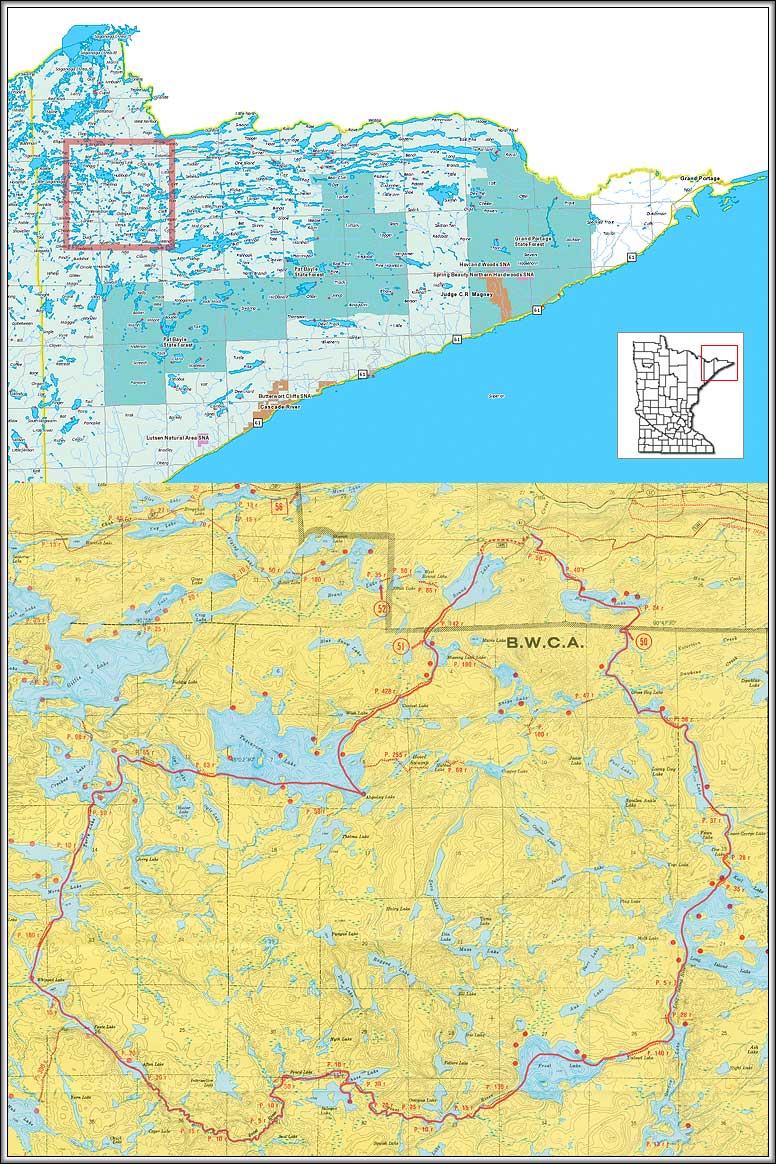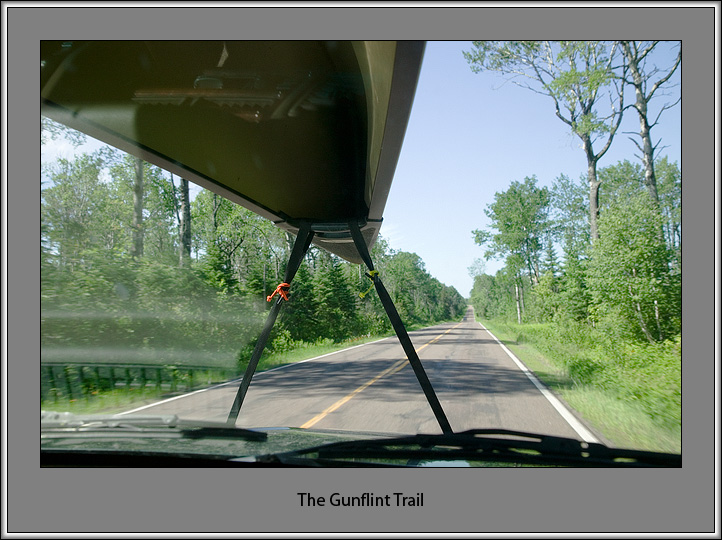| << Prev | Intro | Day 1 | Day 2 | Day 3 | Day 4 | Day 5 | Day 6 | Day 7 | Day 8 | Day 9 | Next >> |
Introduction
"Those Bungee Dealee Bobs are worth their weight in gold", I say to my wife Heidi, as we roll the Jeep out of her Aunt's driveway and head for the freeway. We had just finished dropping off dog number two, Aja, with Aunt Helen, and as the well behaved elder Beagle in our household, she is getting comfortable accommodations while Heidi and I travel up North. Our newest and less fortunate mutt Katy, on the other hand, is instead getting the kennel treatment for the full eleven days. Heidi and I just aren't comfortable with the idea of unleashing sixty plus pounds of rambunctious eight month old puppy on Helen quite yet.
On the way to drop off Aja, the tight straps holding down our green Old Town canoe to the top of the car had started buzzing in the wind. Before leaving Aunt Helen's, I had dug into my small red day pack for a handful of the nifty little Bungee Dealee Bob gizmos that we had recently purchased to help tie loose gear, like paddles and fishing rods, to the canoe. The BDBs were among an assortment of new gear we would be trying out for the first time on this trip, and their first application would officially mark the beginning of our latest boundary waters adventure. So I quickly bound together each canoe strap pair with a brightly colored BDB to prevent them from vibrating, and off we drove. The saying "those Bungee Dealee Bobs are worth their weight in gold" would become our catch phrase for the trip, and we laugh over this as we escape the outskirts of the Twin Cities, driving north toward Duluth and to the BWCAW beyond. Months of planning and anticipation are finally over, and we are very excited to get into the wilderness.
Heidi and I are relative newcomers to the boundary waters experience. I grew up in suburban Chicago and did not do a lot of camping when I was younger. Heidi, on the other hand, was raised in Wisconsin, where I believe camping is a requirement of citizenship. Needless to say, she brings the bulk of our collective outdoors experience to the marriage.
After moving quite a bit over our eleven year marriage, with stints in Milwaukee, WI; Portland, OR; and Seattle, WA; Heidi and I have finally settled into the east Twin Cities metro these past five years. Two years ago we made our first trip into the boundary waters and immediately fell in love with it. Ever since then, we've made it our wedding anniversary tradition, going every June. Each year we push a little farther, attempting more portages, exploring more challenging places, and traveling deeper into the wilderness. Each time we learn immensely more about this amazing place, what's required to travel within it and a lot about ourselves. With each visit, my desire to return increases many times over.
By far, this year's trip will be our most challenging to date, and along with the excitement, there is also a healthy dose of nervousness. At forty years old, with the latter half spent mostly in a chair staring into computer monitors, I'm not exactly at my peak physical conditioning. Our first trip two years ago was fairly easy, only requiring a few pull-overs on Hog Creek and otherwise consisting of a leisurely base camp on Perent Lake (until 25+ knot winds made for a rather exciting and difficult exit on our last day, but that's another story). Last year we made a series of one and two day trips around Lake One and the South Kawishiwi River. There we got a solid dose of portaging and experienced a taste of the deeper wilderness when we traveled along Pagami Creek, through the Weasel Lake Primitive Management Area, while looking to see if there might be a way to Clearwater Lake. Though unsuccessful in our attempt to find passage from Lake One to Clearwater, this small taste of exploration in the more primitive and secluded wilderness really struck a chord. Even before returning from the trip, the gears were already set in motion planning a return trip that would emphasize more of this brand of wilderness experience.
So when the maps came out to start the planning for this year's adventure, I knew just what kind of place I was looking for. It would be off the beaten trail, secluded, primitive and wild. There would be small lakes and rivers, creeks and bogs. It would be the kind of place where the wilderness comes right up to devour the canoe, and where the wild things living within are genuinely surprised to see you. But I knew getting to such a remote location would be considerably more difficult than anything Heidi and I had experienced before. To reach a place where few people go usually means taking a route that's tough to navigate.
I finally found what I was looking for on Fisher map F-12, on the west side of the Gunflint Trail. Approximately ten miles from the trail's end, a loop extends from the Cross River and Ham Lake south through Long Island Lake and then west along the Frost River. The Frost River section is long, winding, sprinkled with small lakes and lined with numerous portages. The sole campsite in this area, about midway through on Bologna Lake, is a clear indication to me that this is not a heavily traveled route. In fact, the campsite wasn't even listed on my McKenzie map or in the GPS data I had found online. Perfect!

The remaining portion of the loop after the Frost River would return us back to our starting point by way of more heavily traveled areas beginning at Mora Lake and continuing on through Crooked and Tuscarora. This would hopefully be the more relaxing point of the trip where we could rest a bit after the many portages and other challenges the Frost River would likely throw our way. In all, we reserved eight days (seven nights) to complete this loop. We'd plan on making four separate camps along the way, leaving us with three layover days to use however we'd like. This would give us a good mix of travel and rest time while still leaving plenty of slack in the schedule to compensate for our inexperience. The portage total came in at around forty portages, which is roughly four times the combined total for all (two) of our previous trips. Among those, there would be the over mile long (360 rod) portage from Tuscarora to Missing Link on our final day and assorted others in excess of 100 rods - all of these longer than any we had traveled before. It was shaping up to be our first real serious boundary waters trip. By comparison, the previous ones were just warmups, a mere dip of the toe into the lake.
So with canoe straps now tightly secured with BDBs, we ramble on toward the Minnesota arrowhead with spirits high and excited minds focused on the adventure just ahead of us.

| << Prev | Intro | Day 1 | Day 2 | Day 3 | Day 4 | Day 5 | Day 6 | Day 7 | Day 8 | Day 9 | Next >> |